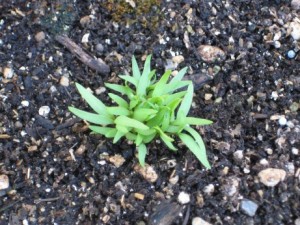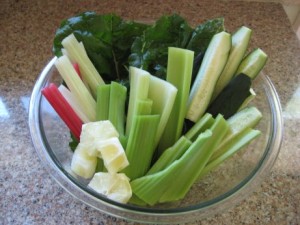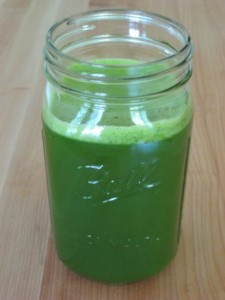Rick and I returned home from a long weekend out of town to find that our goji seeds had germinated! We are so excited! Here is a photo of two growing together.
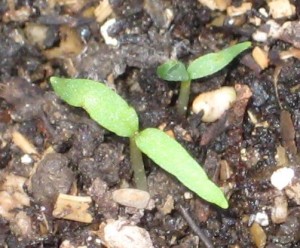
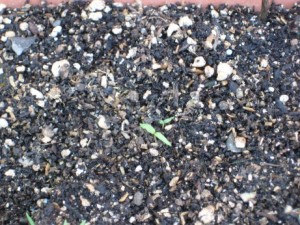
Here is a group of very young goji plants growing together. I planted a whole berry here and it appears that many of the goji seeds germinated.
Our next task is to thin the plants so each can have more space to grow. We’ll keep you updated on their progress. 🙂
One of the best ways to keep in touch with us is to join our email list. You’ll receive a free copy of Our Top 12 Strategies for Long Term Success on A Raw Plant-Based Diet eBook along with regular information about raw food and plant-based diets and periodic promotions for our classes, events, and other offerings!
A Variation on My Favorite Green Juice
Several months ago, I was at my local farmer’s market and saw some Swiss chard starts for sale from a local garden plant vendor. I have never grown chard before, so I thought it would be fun to give it a try. Well, now Rick and I have LOTS of chard growing in our garden and have the opportunity to use it in different recipes. Yesterday, I had a couple of
chard leaves in my morning smoothie and today I thought I would try it in a green juice.
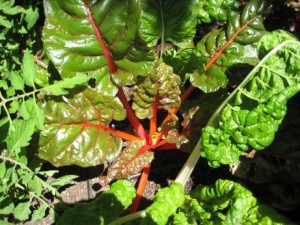
My favorite green juice recipe contains celery, cucumber, the juice of one lemon, and some type of leafy green. For the green, I like to use either kale or dandelion greens, but since I have fresh chard from the garden I used 3 leaves of it in my juice.
Here are the ingredients of the juice: four stalks of celery, one large cucumber, one peeled lemon, and 3 leaves of Swiss chard. I used our twin gear juicer to make the juice and it was really good! I really love the tart lemon taste. One can add apple or some other fruit for a sweet taste, or leave out the lemon for a “green” taste.
A nutrition note: Raw Swiss chard is NOT a rich source of calcium, due to its high oxalic acid content. I do not rely on it as a source of calcium, nor do I make juice out of it often. Swiss chard is in the goosefoot plant family, the same family as spinach and other foods that are high in oxalic acid.
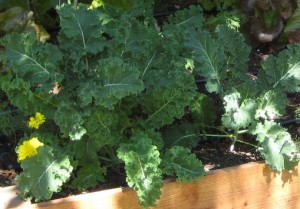
Leafy greens that are lower in oxalic acid include cabbage family plants such as kale and bok choy. There are plenty of plant food sources of calcium that we cover in our course the Science of Raw Food Nutrition Level I and will cover in future blog posts.
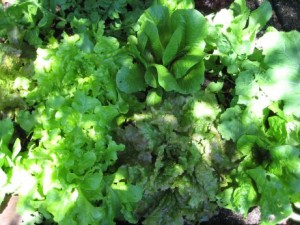
Some non-cabbage family leafy vegetables that I enjoy in salads include dandelion greens, endive, escarole, frisée greens (curly endive), and lettuce, of course. We’ll leave my salad contents for a future post. 🙂
Growing goji berry plants
At the time, I had never before seen an actual goji plant growing in a garden, given that goji berries are native to Asia and are not popularly cultivated as a garden crop here in the United States. Not surprisingly, the berries on the plant reminded me of tiny Roma tomatoes, given that goji berries (lycium barbarum) are in the nightshade plant family (Solanaceae), the same plant family as tomatoes, potatoes, bell peppers, eggplant, and Incan berries (a.k.a. golden berries).
I was excited to find after doing a little research that goji plants can grow in the area where Rick and I live. I am a big fan of locally grown food, so I thought it would be fun to grow some goji berry plants in my backyard garden.
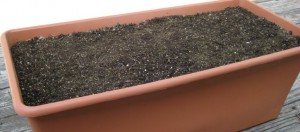
Today, I looked for a suitable container in which to grow my goji seeds. I found an unused planter, filled it with soil, and made ½ inch deep holes about 2 inches apart. I opened several goji berries to find 20+ tiny seeds in each, which I carefully removed and did my best to place one seed in each of the holes. In several of the holes, I placed a single goji berry to see if multiple seeds would germinate together. I filled in the holes with soil and then watered the planted seeds and soil.
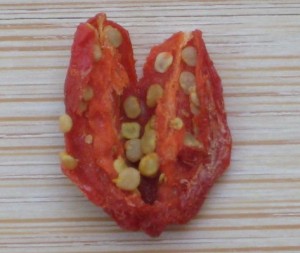
Now that the seeds are planted, I am looking forward to seeing how many, if any, actually germinate and produce plants. I’ll give you updates as the growing season progresses. 🙂
We are happy to announce….
our first blog post! We are looking forward to writing about various topics that inspire us and have helped us achieve our personal health goals.
As expected, we will be writing about fresh whole natural plant foods from a scientific/ research perspective in a relatable and fun manner. Our goal is to regularly cover topics that you find to be valuable, so our question to you is: what health and nutrition subjects would you like to read on our blog? Please let us know by writing your suggestions in the comment section below.
Yours in health,
Drs. Karin and Rick Dina, D.C.
One of the best ways to keep in touch with us is to join our email list. We send out monthly newsletters, notifications of our speaking engagements, and more:

